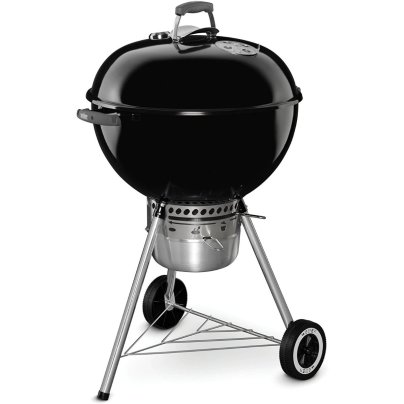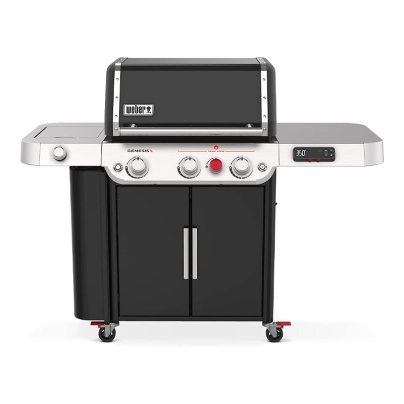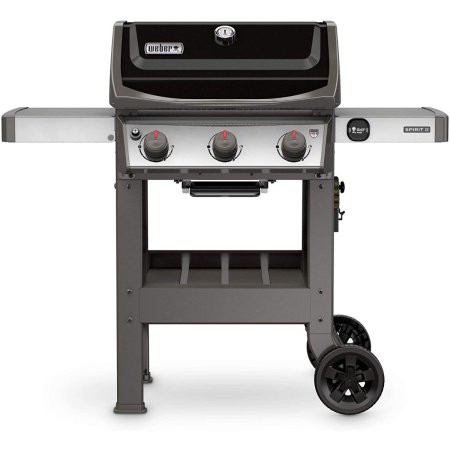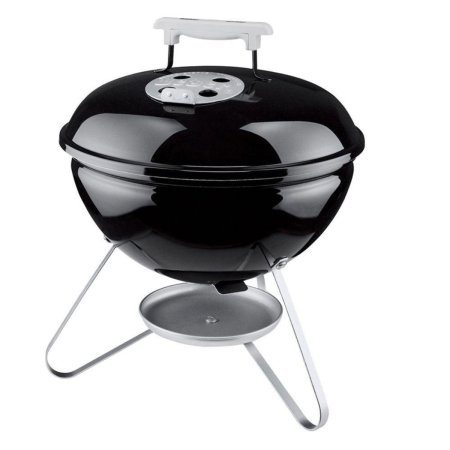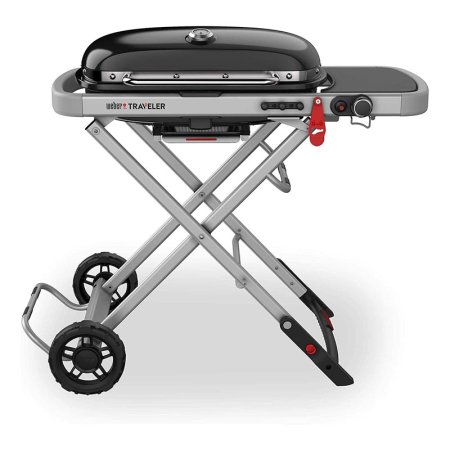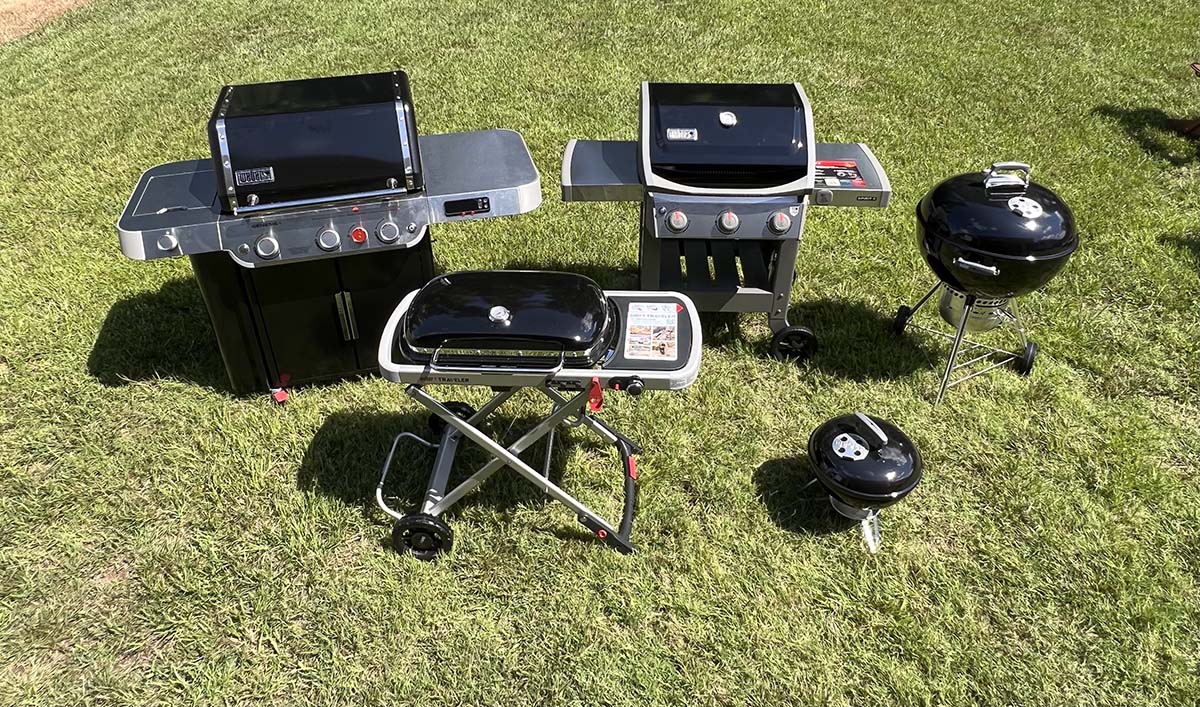
We may earn revenue from the products available on this page and participate in affiliate programs. Learn More ›
Of the many brands of grills on the market, Weber is one of the best thanks to its reputation for making reliable and durable high-performance gas and charcoal grills. While buying a Weber grill is a smart choice, there are many different models to choose from, ranging from Weber’s classic charcoal kettle grill to its high-performance gas grills and newer smokers.
But what makes Weber such a great brand for grills, and what types of grills does Weber offer? We sought to answer this question by subjecting Weber’s grills to rigorous hands-on testing. We used the manufacturer’s charcoal, gas, and portable grills to find out how some of the best Weber grills on the market perform.
- BEST OVERALL: Weber Original Kettle Premium Charcoal Grill
- BEST BANG FOR THE BUCK: Weber Spirit II E-310 Gas Grill
- BEST GAS: Weber Genesis EPX-335 Smart Gas Grill
- BEST PORTABLE: Weber Smokey Joe Charcoal Grill
- BEST FOR CAMPING: Weber Traveler Portable Gas Grill
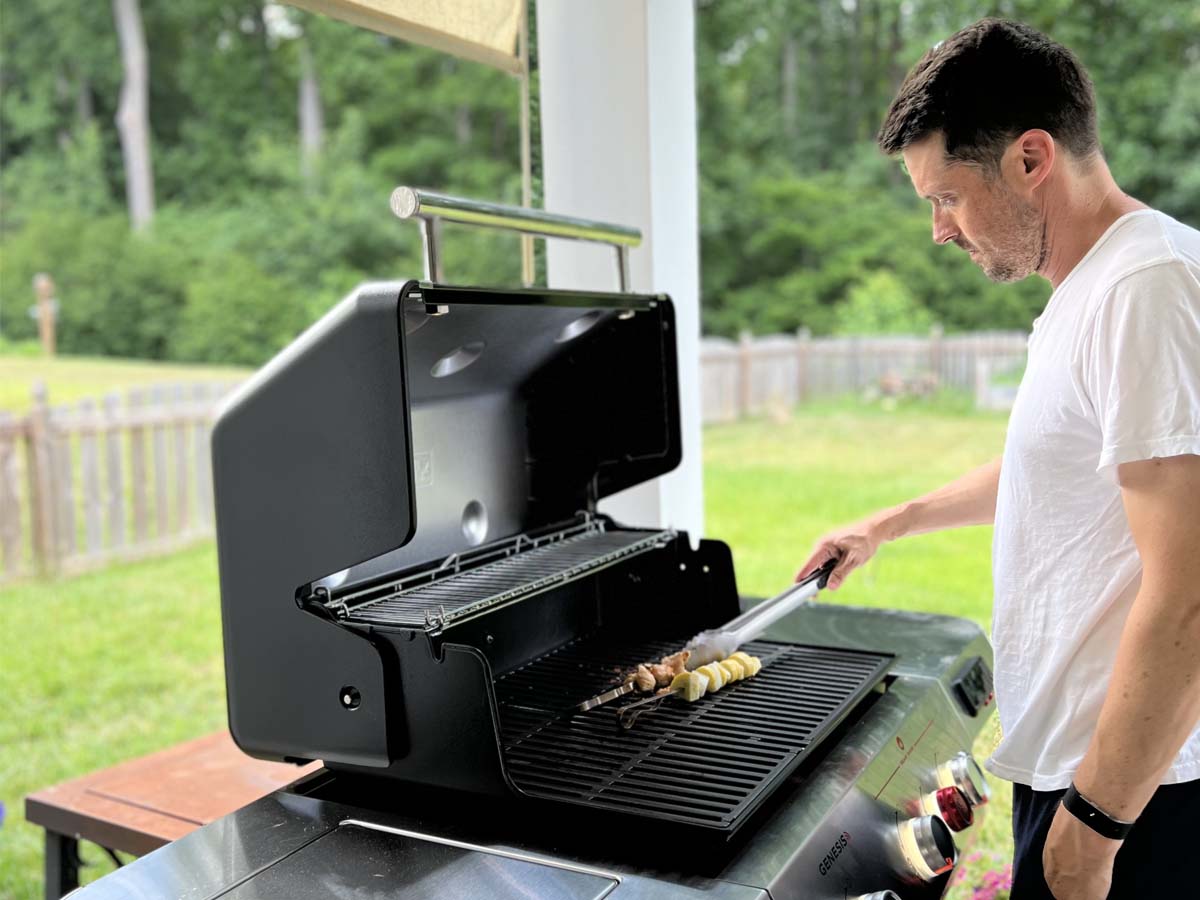
What to Consider When Choosing the Best Weber Grill
Weber’s product line is diverse, with the company manufacturing charcoal, propane, and wood-pellet grills. Ahead, learn more about the different types of grills Weber offers and the important factors to consider when shopping for one.
Types of Weber Grills
There are four main types of Weber grills, and they are categorized by the type of fuel used: charcoal, liquid propane, wood pellet, and electric.
Charcoal
Weber is well-known as the inventor of the charcoal grill (after all, it is part of the company’s logo), so it stands to reason that the company’s charcoal grills would be among the most highly regarded on the market.
Its line of charcoal grills ranges from its popular Smokey Joe 14-inch grill up to its 22-inch premium charcoal grill. Weber also makes a charcoal kamado grill, which has a ceramic body, and a charcoal smoker.
Liquid Propane
While Weber may be best known for inventing the kettle charcoal grill, its propane gas grills are just as popular, if not more so. The company’s range of gas grills includes its mid-tier Spirit series, its high-end Genesis gas grills, and its top-end Summit grills, which include a mix of built-in and freestanding grills.
Wood Pellets and Electric
Though it’s not a large part of its business, Weber also offers two sizes of higher-end wood pellet grills and three electric grills designed for portable use.
Size
When choosing a grill, paying attention to size is key as it determines how much food one can cook at a time. Grill size is typically measured by the size of the cooking surface. One of the best ways to determine size is to consider how many people the grill needs to accommodate.
About 200 square inches of cooking space is suitable for one to two people, while 450 square inches is a good size for a family of four. Larger families and those who frequently entertain may require a grill with 500 to 650 square inches of cooking surface.
Grill Material
Weber charcoal grills consist of a steel body coated with a porcelain enamel that’s baked on at 1,500 degrees Fahrenheit to withstand high temperatures. The company’s gas grills are made from stainless steel, aluminized steel, or cast iron. Construction varies depending on the grill’s price point.
While Weber’s Spirit series uses bent sheet metal for its construction, the company’s higher-end Genesis series consists of thicker and sturdier welded beams. Weber uses either stainless steel bars (charcoal) or porcelain-enameled cast-iron grates (gas) for the cooking surfaces on its grills.
Wheels
Larger Weber gas and charcoal stand-alone grills have wheels that make them easier to move around a patio or deck. Weber’s charcoal models as well as some of its gas grills have two wheels on one side that allow the user to move the grill by tilting it backward. Its higher-end freestanding gas grills sit on large casters that allow the user to roll them around a smooth surface.
Performance
Weber is known for integrating its grills with innovative technologies that improve performance and ease of use. Weber’s gas grill, for example, includes its GS4 system, which consists of an igniter that can set the temperature for the entire grill at once, high-performance burners that last longer, metal bars that decrease flare-ups and improve flavor by evaporating juices, and a handy grease-management system under the firebox.
Most of Weber’s gas grills are compatible with iGrill 3 app-connected technology, which consists of a small Bluetooth unit on the front of the grill. The unit connects up to four compatible meat thermometers, sold separately, to a smart device, allowing the chef to monitor meat temperatures remotely.
Ash Catcher
Weber’s charcoal grills have trays under the bottom grill vents designed to catch ash. Smaller grills, such as the Smokey Joe, have simple small metal trays, while larger models, including Weber’s premium charcoal grill, have systems that allow the user to sweep ash from the bottom of the grill into the catcher. The catcher can be removed, eliminating the need to move the entire grill to dispose of the ash.
Portability
While most of Weber’s larger grills have wheels, that doesn’t make them portable. The wheels on these larger grills are designed for transporting them over short distances, such as from one side of a patio to the other. Weber does have a line of portable grills, which includes its smaller Smokey Joe and Jumbo Joe charcoal grills, Go Anywhere collapsible charcoal grill, and Traveler small gas grill.
These grills, which are compact and light enough to load into the trunk of a car for transport to a campground, park, or tailgating event, offer between 200 and 320 square inches of cooking surface.
Additional Accessories
In addition to grills, Weber also sells a broad range of grilling accessories, including high-quality grill covers, chimney starters, cooking utensils, rotisserie kits, scrapers, and cleaning kits.
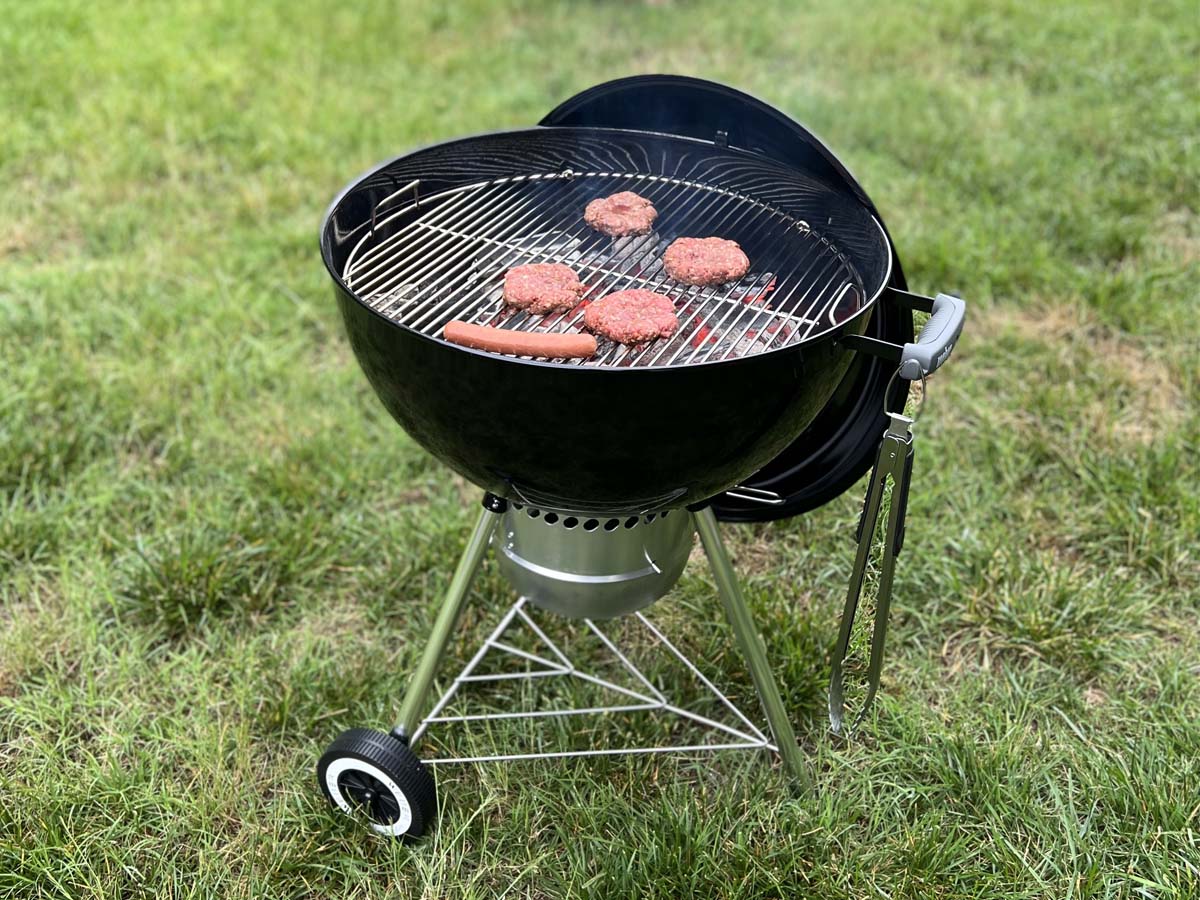
Our Top Picks
We tested some of the best grills Weber has to offer, and the results are below. The list includes classic gas and charcoal grills that the company has produced for years as well as some of Weber’s newest editions, including its line of pellet grills and smokers.
Best Overall
Weber Original Kettle Premium Charcoal Grill
Pros
- Excellent ash-disposal system
- Good capacity for charcoal grill
- Well-designed venting system
- Sturdy construction
Cons
- Expensive for a charcoal grill
Weber introduced the first kettle grill nearly 70 years ago, and it continues to be one of the company’s most popular grills today. After putting all three of Weber’s kettle grills through their paces, the Premium is clearly the best of the bunch.
It’s the largest of Weber’s kettle grills with a cooking surface that is 22 inches in diameter, which means users can load more charcoal into it, giving it the ability to reach higher temperatures. Our heat test recorded temperatures approaching 900 degrees Fahrenheit with standard charcoal briquettes, which is notably hotter than the Premium’s smaller cousins.
The broader cooking surface not only creates ample room for food but also makes it easier to cook at different temperatures simultaneously. The kettle is large enough to pile briquettes on the side while leaving the other half empty, creating two cooking zones.
In addition to being the largest of Weber’s kettle grills, the Premium differentiates itself with its ash-collection system. A lever just under the kettle controls the Weber’s lower vents while also moving sweeper blades inside the kettle that push ashes through the vent holes and into an enclosed ash catcher. Weber’s other grills use a metal tray that sits under the kettle.
The container can hold far more ash than a tray and keeps the ash enclosed while it’s attached to the grill, which is great for people who have a dog that loves to stick its muzzle into the ash. The container also makes disposing of ash easy and mess-free. Simply detach the catcher from the bottom of the grill and carry it to a trash can.
While the ash catcher is a big part of what makes the Premium such a standout, there are other thoughtful design features that are also notable. Weber wisely designed the lid handle with a metal heat deflector that prevents the handle from warming up to burn-inducing temperatures. There’s also a section of the cooking grate that hinges upward, which makes it easy to add additional charcoal in the middle of grilling.
While all of these design features make it such an attractive grill, the Premium also comes at a premium price. It costs nearly twice as much as Weber’s 18-inch kettle grill. Still, for those looking for a charcoal grill with ample cooking surface, features that make it easier to cook with charcoal, and a long-lasting reputation, the Premium can be worth the investment.
Product Specs
- Cooking surface: 363 square inches
- BTUs: N/A
- Type: Charcoal
Get the Weber Original Kettle Premium Charcoal Grill at Amazon, The Home Depot, Ace Hardware, or BBQGuys.
Best Bang for the Buck
Weber Spirit II E-310 Gas Grill
Pros
- Ample heat for cooking surface
- Supports iGrill 3 thermometer system
- Affordably priced
Cons
- Propane tank is visible
Weber’s newest line of Spirit grills showcases some of the cutting-edge technology Weber brings to bear with its line of gas grills. Aside from a few misses in design, the E-310 is a formidable grill at a relatively affordable price point.
While assembling the Weber Spirit II E-310, it was clear that it has exceptional build quality. The grill body consists of heavy-gauge sheet metal that gives it a sturdy feel. There’s no swaying or bowing with this grill, nor are there any pieces that don’t properly align. The lid is coated in the thick, virtually indestructible enamel paint found on many Weber grills, while high-quality porcelain-coated cast-iron grates are under the hood.
The E-310 model also comes with Weber’s new GS4 cooking system, which boasts high-performance burners, an advanced ignition system, “flavorizer” bars, and a grease-management system. It also supports Weber’s iGrill 3 app-connected thermometer system, which is a separate purchase.
This GS4 system translates into solid cooking performance. The E-310’s electric ignition makes it easy to light all burners at once. While the E-310 didn’t get as hot as Weber’s higher-end Genesis grills, it did register temperatures around the 550-degree Fahrenheit mark, allowing us to sear burger patties and steaks with relative ease.
The three burners coupled with 529 square inches of cooking surface allowed us to create multiple heat zones for cooking foods or searing and finishing steaks and burgers. Weber says its flavorizer bars are designed to create smoke that infuses flavor into food. While we were skeptical at first, they were effective at creating more flavorful food. The tray collects grease nicely and is easy to access and empty.
Although the design changes from the previous generation of the Spirit are mostly good, we did have a few gripes. Whereas the earlier version of the Spirit concealed the tank behind an enclosed cabinet, the new Spirit places the tank on the exterior of the grill. While the design change opens up under-grill space for storage and makes tank installation easier, it leaves the unsightly propane tank exposed while the grill is uncovered, which is a turnoff for those who care about the aesthetics of their outdoor living space.
The Spirit II is also more bare-bones when compared to the loaded Genesis. There are no sear burners, side burners, or options for smart controls. But, given that the Spirit II is hundreds of dollars cheaper than the Genesis, it’s a heck of a deal for a high-performing and durable gas grill.
Read our full review:Weber Spirit II E-310 Gas GrillProduct Specs
- Cooking surface: 529 square inches
- BTUs: 30,000 (3 burners)
- Type: Gas
Get the Weber Spirit II E-310 Gas Grill on Amazon, The Home Depot, or Ace Hardware.
Best Gas
Weber Genesis EPX-335 Smart Gas Grill
Pros
- Digital smart controls and thermometer
- Large cooking surface
- High-quality construction
- LED lighting and additional storage
Cons
- Expensive
- More than 5 feet wide
Weber pushes the envelope in gas-grill technology, and nowhere is that more apparent than with its Genesis series, which feature smart controls, innovative storage designs, and specialized burners, making it the best all-around gas grill we tested from the company.
Genesis represents the higher-tier line of Weber gas grills, and that’s apparent with the EX-335 in the sheer number of additional features that it has. As many may expect, Genesis has more cooking space than the more affordable Spirit line of grills with nearly 800 square inches of cooking surface, which is well supported by three main burners plus a sear burner. It was easy to sear burgers and a steak on the sear station and then transfer each piece of meat to the cooler half of the grill for finishing.
Weber’s gas grills are generally hotter than other gas-grill brands, but the sear burner takes it to another level. We recorded heat output approaching charcoal-grill levels of 800 degrees on the Genesis’ searing station. This made searing a crust on our ribeye far easier than with a standard grill burner.
While the sear burner is a great feature, what really sets the 335 apart is its Weber Connect smart controls, which consists of a display with three control buttons on the side table. Weber Connect keeps tabs on the internal temperature of the grill while also providing ports for multiple digital thermometers for tracking meat temperature. Users can view temperature readings via the on-grill display or on a smartphone via the Weber Connect smartphone app. We’ve used digital thermometers on other grills and smokers in the past and found them to be temperamental, often dropping connection with our smartphone mid-cooking. We had no such problems with Weber Connect, which provided accurate meat temperature readings for our steaks and maintained its connection through the grilling process even when our phone went into sleep mode.
In addition to smart controls, there are other bells and whistles included on the 335 that aren’t necessary for a gas grill but are really nice to have, including LED lighting for the control knobs and under-hood lights that illuminate the grill surface with the lid up. The Genesis offers innovative storage in the form of an under-grill cabinet, which also houses the propane tank. There’s a handy side cabinet located under the side burner for grill tools and additional supplies—a slick use of what would otherwise be wasted space.
While all of these features make the Genesis a premium grill, they also extend its build time. It took us a solid 2 hours to put it together due mainly to the additional wiring required for the digital controls and side burner. That said, it could have easily taken longer were it not for Weber’s use of Bilt, a third-party smartphone app that provides animated step-by-step assembly instructions that are much easier to follow than the standard paper instructions.
Product Specs
- Cooking surface: 787 square inches
- BTUs: 39,000
- Type: Gas
Get the Weber Genesis EPX-335 Smart Gas Grill on Amazon, The Home Depot, or BBQGuys.
Best Portable
Weber Smokey Joe Charcoal Grill
Pros
- Weighs less than 10 pounds
- Ample cooking surface for a portable grill
- Dual air vents for temperature control
- Durable construction
Cons
- Lid doesn’t attach to the bottom for transport
The Smokey Joe, which is essentially a smaller 14-inch version of Weber’s full-size kettle grill, has been one of the most popular portable grills on the market since it debuted in 1955, and for good reason. Our tests reveal that the Smokey Joe is easy to light, burns hot, and has features that make it relatively easy to control the temperature.
One of the first things we noticed about the Smokey Joe is how well it heats with a minimal amount of fuel, which is a testament to the amount of air space its bulbous body creates. With just a small load of charcoal, we registered cooking surface temperatures well above 700 degrees, more than hot enough to reach sear-worthy temperatures.
It’s usually difficult to control temperature with a small charcoal grill, but that’s not the case with the Smokey Joe. The large vents on both the base and the lid made it easy to squelch the charcoals without extinguishing them. We only wish that the vent tabs were insulated, as they became impossible to touch with bare hands once the grill was hot.
The Smokey Joe’s 147 square inches of cooking space is about average for a portable charcoal grill. While the cooking surface is compact, there’s enough room to handle a half-dozen burgers or a couple of steaks. Although the Smokey Joe is small and lightweight, its three legs offer a stable base for the kettle. The grill didn’t budge even when we were vigorously flipping burgers.
In terms of portability, the entire grill weighs 10 pounds, making it ideal for throwing in a trunk or the back of a truck for camping, tailgating, or a trip to the beach. Our only gripe is that there is no way to lock the lid to the base, making it more difficult to carry. The unsecured lid also makes it tricky to transport if users are unable to dump the used ash and charcoal before making the return trip. There is a premium version of the Smokey Joe that has a locking bar for the lid, but it places the bottom vents on the side of the grill body, which is less effective for promoting airflow.
Aside from those minor flaws, it’s hard not to love the Smokey Joe. It’s a great portable charcoal grill—or even an ideal at-home option for those with limited space for a grill.
Product Specs
- Cooking surface: 147 square inches
- BTUs: N/A
- Type: Charcoal
Get the Weber Smokey Joe Charcoal Grill at Amazon, The Home Depot, Ace Hardware, or BBQGuys.
Best for Camping
Weber Traveler Portable Gas Grill
Pros
- Can grill or smoke
- Smart controls
- Built-in Bluetooth or Wi-Fi temperature monitoring
Cons
- Expensive
At a little more than a year old, the Weber Traveler is one of the grill manufacturer’s newest products. And what a grill it is. The Traveler offers the same quality build, exceptional performance, and smart designs found in Weber’s other grills. Plus, assembling this portable gas grill took us less than 10 minutes, a welcome change to the 2-hour assembly time of most full-size gas grills.
The Traveler is designed to be easy to transport a short distance from car trunk to campsite or tailgating event. Despite the fact that it weighs nearly 50 pounds, it’s surprisingly easy to move. Two large wheels on the end allow users to roll the Traveler like a piece of wheeled luggage.
We love the fact that this grill comes equipped with its own stand and doesn’t require a tabletop. Once it’s in position, unfolding it is simple. Simply release the safety lock, place a foot on one end of the stand, squeeze the release, and pull the grill upward to bring it to its standing height. A hydraulic arm assists, making it easier to raise.
The Traveler is powered by a 1-pound propane gas canister that attaches to a valve mounted under the grill body. While the valve houses the canister securely, we found it difficult to access. It took us a few attempts to seat the canister properly on the nozzle so we could screw it in.
The most striking feature of the Traveler is the sheer size of its cooking surface, which spans some 320 square inches, making it not much smaller than Weber’s two-burner Spirit gas grill. As with Weber’s other grills, the Traveler’s build is solid with heavy-gauge sheet metal, a sturdy stand, and porcelain-coated cast-iron grates.
There are other little features we like about the Traveler, too. It has a good-sized side table for prepping food, a useful thermometer on the grill lid, hooks for hanging grill tools, and a removable metal grease tray.
The Traveler is equipped with a large circle-shaped burner that does an excellent job of heating the grill surface. We recorded surface temperatures near 500 degrees, which was enough to create nice grill marks on burgers. However, we don’t like that the Traveler only has a single burner, which limits the grill to a single cooking zone. It’s also one of the more expensive portable gas grills on the market. But, for those looking for a high-quality gas grill that’s easy to move over short distances, has a broad cooking surface, and has a durable build, then the Traveler is an excellent choice.
Product Specs
- Cooking surface: 320 square inches
- BTUs: 13,000
- Type: Gas
Get the Weber Traveler Portable Gas Grill at Amazon, The Home Depot, Ace Hardware, or BBQGuys.
Our Verdict
With its time-tested kettle design and premium features that make it easier and less messy to cook with charcoal, the Weber Original Kettle Premium Charcoal Grill is the best all-around grill we have tested from this manufacturer. Those looking for the best gas grill may want to consider the Weber Genesis EPX-335 Smart Gas Grill with its high-performance sear burner and smart controls.
How We Tested the Best Weber Grills
Weber has a reputation for making some of the most durable and high-performing gas and charcoal grills on the market. To find the best of what this manufacturer has to offer, we subjected the grills to rigorous testing. We used a scoring rubric to assess each grill for ease of assembly, ease of cooking, overall performance, and durability.
To ensure consistent testing, we grilled boneless, skinless chicken on the grill to determine how evenly each grill cooked. To test searing capability, we cooked a hamburger patty and steak on each grill. In addition to grilling, we also assessed each grill for additional features such as smart controls, storage, digital thermometers, and ignition systems.
Cleanup is also crucial, so we assessed the difficulty level of cleaning the grill post grilling, taking into account ash-catching trays and grease pans.
The Advantages of Owning a Weber Grill
Although the Weber name comes with a higher price point than some other grill brands, it’s for good reason. Weber has a great reputation for the durability of its grills. The materials Weber uses may raise the overall price of the grill, but it will probably last longer than lesser grills, helping to defray the cost difference. The manufacturer’s grills, be they gas or charcoal, also consistently perform well with excellent heat output and distribution. They also have features that make it easy to control the temperature.
Weber grills offer many features that make them easy to use—from using Bluetooth to monitor the progress of steaks sizzling from the comfort of a living room sofa to easy post-grilling cleanup using a removable ash collector. Weber grills are also among the more stylish grills, with many of the company’s most popular models coming in several color options including black, stainless steel, and green.
- Durability gives Weber grills a long lifespan
- User-friendly controls make grilling easier
- Stylish with multiple color options
- High performance
FAQs
If you’re wondering about how to clean your new Weber grill or how long you can expect the grill to last, then read on for answers to these and other frequently asked questions about Weber grills.
Q. How long do Weber grills last on average?
With proper maintenance and the use of a good grill cover, a Weber grill can usually last 10 to 15 years.
Q. How do I clean my Weber grill?
Clean the inside of a grill as well as the grates using a stainless steel grill brush. Scrape any buildup off the deflection panels or bars using a plastic scraper. Next, use a stainless steel brush to clean the burner tubes under the heat deflectors. Finally, check out the inside of the cook box and scrape away any debris or residue that can cause flare-ups.
Q. Which type of wood pellets should I get for my Weber grill?
If you have a Weber pellet grill or smoker, purchase pellets designed for grilling. While Weber sells its own pellets, most brands of grilling pellets will work. Pellets typically come in different types to infuse different flavors into the food.
Q. How long can my Weber grill stay on without it getting damaged?
Since Weber grills are designed to endure temperatures far greater than what the grill can actually achieve, it won’t damage the grill to leave it on for extended periods of time. That said, if you forget to turn off a gas grill, it can eventually cause the tank valve to go into a bypass state, a safety feature that reduces the flow of gas. Once in bypass state, a grill won’t heat greater than 300 degrees. If that happens, you’ll need to go through a process to reset the valve.
Q. Should I wash my Weber grill?
Although it’s possible to hose off a Weber grill or even power-wash it, it’s probably not a good idea to do so. Washing a Weber grill with pressurized water can force water into cracks and crevices, where it can cause rust to form. Instead of using a hose, scrape off buildup with a wire brush and wipe down the grill with a wet cloth.
